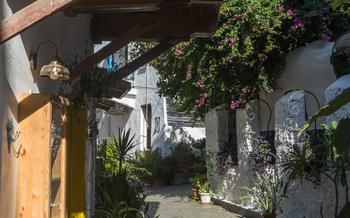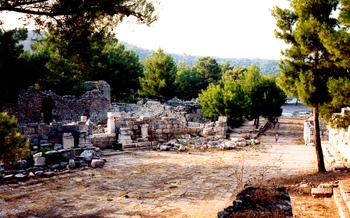
Xanthos Ancient City
- Xanthos Ancient City: A Journey Through Time
- Exploring the Architectural Masterpieces
- The Necropolis: A Glimpse into Ancient Burials
- Xanthos Theater: A Stage for Ancient Performances
- Lycian Tombs: A Unique Burial Tradition
- Xanthos Museum: Unveiling the City's Treasures
- The Agora: A Hub of Economic and Social Activity
- Xanthos Obelisk: A Symbol of Victory
- The Granary: A Storehouse of Ancient Resources
- The City Walls: A Defensive Fortification
- Local Cuisine: A Taste of Xanthos Flavors
- Festivals and Events: Celebrating Xanthos' Heritage
- Accommodation and Lodging Options
- Insider Tip: Hidden Gems and Off-the-Beaten-Path Sites
Xanthos Ancient City: A Journey Through Time
In the heart of Turkey's stunning Antalya region, nestled amidst picturesque landscapes, lies the ancient city of Xanthos, a remarkable testament to the Lycian civilization. Xanthos, with its rich history dating back to the 5th century BC, played a pivotal role as the capital of the Lycian League, a powerful confederation of cities. Its strategic location at the crossroads of important trade routes contributed to its prosperity and cultural significance.
Over the centuries, Xanthos has undergone various transformations, witnessing the rise and fall of empires, the blending of cultures, and the devastating effects of natural disasters. Archaeological excavations conducted throughout the 19th and 20th centuries uncovered a treasure trove of artifacts, shedding light on the city's glorious past and its significant contributions to ancient civilization.
Xanthos' exceptional cultural and historical value has earned it recognition as a UNESCO World Heritage Site, further solidifying its status as a must-visit destination for history enthusiasts, archaeologists, and travelers seeking to delve into the depths of ancient Anatolia.
Exploring the Architectural Masterpieces
Xanthos, a city steeped in history and cultural significance, is renowned for its impressive architectural legacy. The ancient city boasts a remarkable collection of well-preserved structures that showcase the architectural prowess of the Lycians.
Lycian-Style Architecture: A Distinctive Blend
Lycian architecture, a unique fusion of Anatolian and Greek influences, sets Xanthos apart from other ancient cities in Turkey. Lycian builders employed innovative techniques and incorporated distinctive elements into their designs, creating a harmonious blend of functionality and aesthetics.
City Walls and Gates: Guardians of Xanthos
The city walls of Xanthos, constructed with massive stone blocks, once encircled the city, providing protection from invaders. These formidable fortifications featured several gates, each adorned with intricate carvings and inscriptions, serving as grand entrances to the city.
Acropolis: The Heart of Xanthos
The acropolis, the highest point within the city, held significant religious and administrative importance. Here, atop the hill, stood the city's most sacred temples, dedicated to various deities. The acropolis also housed government buildings and offered stunning panoramic views of the surrounding landscape.
Temples: Sanctuaries of Faith
Xanthos boasts several well-preserved temples, each dedicated to a specific deity. The Temple of Apollo, the most prominent among them, features intricate carvings and inscriptions that provide insights into Lycian religious beliefs and practices. Other temples, dedicated to Artemis, Leto, and other gods, further showcase the city's diverse religious landscape.
The Necropolis: A Glimpse into Ancient Burials
The necropolis, or city of the dead, is located just outside the ancient city walls of Xanthos. It offers a glimpse into the burial practices and funerary customs of the Lycians. The necropolis is vast, covering an area of approximately 2 square kilometers, and contains a wide variety of tombs dating from the 5th century BC to the 3rd century AD.
The tombs in the necropolis are of various types and architectural styles, reflecting the diverse cultural influences that shaped Xanthos. There are simple rock-cut tombs, elaborate chamber tombs with multiple chambers and decorated facades, and even monumental tombs with intricate carvings and inscriptions.
One of the most striking features of the necropolis is the elaborate sarcophagi, or stone coffins, that adorn many of the tombs. These sarcophagi are often elaborately carved with scenes from mythology, religious symbolism, and everyday life. The carvings provide valuable insights into the cultural beliefs and practices of the Lycians, as well as their artistic prowess.
The necropolis of Xanthos is not only a fascinating archaeological site but also a place of great cultural significance. It offers a glimpse into the lives and beliefs of the ancient Lycians and provides a tangible connection to their rich history.
Xanthos Theater: A Stage for Ancient Performances
In the heart of Xanthos, nestled amidst the ancient ruins, stands the Xanthos Theater, a testament to the city's rich cultural heritage. Built during the Roman period, this magnificent theater once hosted a variety of performances, captivating audiences with its impressive acoustics and architectural grandeur.
With a seating capacity of approximately 2,000 spectators, the theater is a remarkable example of Roman engineering. Its well-preserved stage, orchestra, and seating tiers create an immersive atmosphere, transporting visitors back in time to the era of ancient dramas and musical spectacles.
The theater's acoustics are truly exceptional, allowing performers' voices to carry effortlessly throughout the auditorium. This remarkable feature ensured that even those seated in the furthest rows could fully experience the performances.
The theater was not just a venue for entertainment but also an important center for civic and religious events. It served as a platform for political speeches, poetry readings, and religious ceremonies, reflecting the diverse cultural and social life of ancient Xanthos.
Today, the Xanthos Theater stands as a symbol of the city's enduring legacy. It invites visitors to step into the past, imagining the vibrant performances that once filled the air and left an indelible mark on the history of this ancient city.
Lycian Tombs: A Unique Burial Tradition
In Xanthos, the Lycians developed a distinctive burial tradition that showcased their cultural and religious beliefs. Instead of underground graves, they carved elaborate tombs into the surrounding rocks. These rock-cut tombs are a testament to the Lycian mastery of stonework and their unique approach to commemorating the dead.
The tombs vary in size and design, reflecting the status and wealth of the deceased. Some tombs feature simple facades, while others are adorned with intricate carvings and decorative elements. The most elaborate tombs have multiple chambers and intricate architectural details, showcasing the skill and artistry of the Lycian craftsmen.
The tombs also provide valuable insights into the Lycian culture and their religious beliefs. The elaborate carvings and inscriptions on the tombs depict scenes from mythology, religious rituals, and everyday life, offering a glimpse into the values and beliefs of this ancient civilization. The tombs also reveal the importance of family and lineage in Lycian society, as many tombs were designed to accommodate multiple generations of a family.
Exploring the Lycian tombs is a fascinating journey into the past, offering a unique perspective on the culture and traditions of this ancient civilization. Whether you're an avid history buff or simply intrigued by the mysteries of the past, the Lycian tombs are a must-see attraction in Xanthos.
Xanthos Museum: Unveiling the City's Treasures
Housed in a modern building adjacent to the ancient city, the Xanthos Museum is a treasure trove of artifacts that provide a glimpse into the rich history and culture of Xanthos. The museum's collection encompasses a diverse range of objects excavated from the site, including sculptures, inscriptions, pottery, and everyday items.
Among the highlights of the museum's collection are the numerous sculptures that once adorned the city's temples and public buildings. These exquisitely carved figures depict a variety of subjects, from gods and goddesses to mythical creatures and historical figures. The inscriptions, written in both Lycian and Greek, offer valuable insights into the language, history, and religious practices of the ancient Xanthians.
The museum also houses a collection of pottery that showcases the artistic skills of the Xanthian craftsmen. From simple utilitarian vessels to elaborately decorated vases, these objects provide a glimpse into the daily lives of the city's inhabitants.
The Xanthos Museum is a must-visit for anyone interested in the history and culture of ancient Xanthos. Its collection of artifacts provides a tangible connection to the past, offering visitors a deeper understanding of this remarkable city and its people.
The Agora: A Hub of Economic and Social Activity
In the heart of ancient Xanthos, the agora served as a vibrant marketplace and a crucial center for social interactions. This bustling public square was the economic and social hub of the city, where locals gathered to conduct business, trade goods, exchange ideas, and socialize. Market stalls lined the agora, offering a variety of goods, from fresh produce and handcrafted pottery to imported textiles and exotic spices. Merchants from neighboring regions and beyond converged here to showcase their wares and engage in lively trade.
The agora was not merely a place of commerce but also a center for civic activities. Public buildings, such as the council chamber and the law courts, were located within the agora, serving as venues for important decision-making and legal proceedings. Citizens gathered here to discuss matters of governance, voice their concerns, and participate in the political life of the city. The agora was a place where Xanthians came together to celebrate festivals, religious ceremonies, and special events, reinforcing the sense of community and shared identity.
Xanthos Obelisk: A Symbol of Victory
Amidst the ruins of Xanthos, a remarkable monument stands tall, symbolizing the city's military prowess and glorious victories. Known as the Xanthos Obelisk, this towering structure is a testament to the city's rich history and cultural heritage.
Discovered in the 19th century by British explorers, the Xanthos Obelisk was originally erected in the 5th century BC to commemorate the Lycian victory over the Persians. Carved from a single block of white marble, the obelisk stands at an impressive height, reaching towards the sky like a beacon of triumph.
Its four sides are adorned with intricate reliefs depicting scenes of battle and conquest. These carvings provide a vivid glimpse into the military prowess and valor of the Lycian warriors. The inscriptions on the obelisk, written in both Lycian and Aramaic scripts, narrate the heroic deeds of the Lycian army and celebrate their hard-fought victories.
The Xanthos Obelisk is not merely a symbol of military triumph; it also holds profound cultural and historical significance. It represents the resilience, determination, and unity of the Lycian people in the face of adversity. Furthermore, it serves as a reminder of the rich cultural exchanges and interactions that took place between different civilizations in the ancient world.
Today, the Xanthos Obelisk stands as a proud testament to the enduring legacy of Xanthos. Visitors can marvel at its grandeur and intricate carvings, immersing themselves in the history and culture of this ancient city. The obelisk remains a powerful symbol of victory, resilience, and the enduring spirit of the Lycian people.
The Granary: A Storehouse of Ancient Resources
In the heart of Xanthos, nestled amidst the ancient ruins, lies the Granary, a testament to the city's agricultural prowess and resourcefulness. This impressive structure served as a vital storehouse for grain, a precious commodity in ancient societies. Constructed with sturdy walls and a carefully designed ventilation system, the Granary ensured the preservation and protection of the city's food supply.
Its strategic location within the city walls further emphasized its significance. In times of siege or conflict, the Granary played a crucial role in sustaining the population and maintaining the city's resilience. The sheer size of the Granary speaks volumes about the importance placed on agriculture and food security in ancient Xanthos.
Exploring the Granary today, visitors can marvel at its architectural features and imagine the bustling activity that once filled its vast chambers. The intricate network of ventilation ducts, designed to circulate air and prevent spoilage, showcases the ingenuity of ancient engineers. The sheer scale of the Granary, capable of storing vast quantities of grain, hints at the agricultural wealth and prosperity that Xanthos once enjoyed.
As you stand within the Granary, surrounded by the echoes of history, let your imagination transport you back to a time when this humble structure played a pivotal role in the survival and sustenance of an ancient city. The Granary of Xanthos stands as a testament to the enduring importance of agriculture and the resourcefulness of the people who called this remarkable city home.
The City Walls: A Defensive Fortification
The ancient city of Xanthos was strategically protected by a formidable system of city walls, serving as a defensive barrier against potential invasions and attacks. Constructed with precision and strength, these walls showcased the architectural prowess of the Lycians and their commitment to safeguarding their city. The walls were meticulously crafted using large stone blocks, forming a sturdy and impenetrable barrier around Xanthos.
Along the perimeter of the walls, strategically positioned gates and towers provided controlled access to the city and served as vantage points for vigilant guards. These gates, such as the monumental City Gate, allowed for the regulation of movement and trade while also facilitating the defense of the city. The towers, with their elevated vantage points, offered a panoramic view of the surrounding landscape, enabling sentinels to detect approaching threats and sound the alarm if necessary.
The city walls of Xanthos were not merely defensive structures; they also played a crucial role in shaping the urban landscape and regulating the flow of people and goods. They defined the boundaries of the city, creating a distinct separation between the urban center and the surrounding countryside. The walls served as a physical manifestation of the city's power and autonomy, symbolizing its resilience and determination to protect its people and their way of life.
Local Cuisine: A Taste of Xanthos Flavors
Xanthos is not just a treasure trove of ancient ruins; it also boasts a rich and diverse culinary scene. The local cuisine reflects the region's unique blend of cultures, with influences from neighboring Anatolia and the Mediterranean. Fresh, seasonal ingredients are celebrated, and traditional cooking methods are still widely used.
Must-Try Dishes:
-
Xanthos Kebab: Tender lamb or beef skewers grilled to perfection over charcoal, served with fresh vegetables and tangy sauces.
-
Mezze Platters: A delightful array of small dishes, including hummus, baba ghanoush, stuffed grape leaves, and pickled vegetables.
-
Gozleme: A traditional Turkish flatbread filled with cheese, spinach, or minced meat, cooked on a hot griddle.
-
Pide: A boat-shaped pizza topped with various ingredients like cheese, meat, or vegetables, baked in a stone oven.
-
Xanthos Honey: The region is known for its fragrant honey, produced from the nectar of wild thyme flowers.
Where to Dine:
-
Local Restaurants: For an authentic Xanthos experience, head to the small, family-run restaurants in the old town or near the ancient ruins.
-
Rooftop Terraces: Enjoy panoramic views of Xanthos while savoring local delicacies on a rooftop terrace restaurant.
-
Olive Groves: Immerse yourself in nature and dine amidst olive groves, relishing traditional dishes paired with local wines.
Insider Tip: Don't miss the weekly farmer's market, where you can find fresh produce, spices, and homemade delicacies from local farmers.
Festivals and Events: Celebrating Xanthos' Heritage
Xanthos comes alive with a vibrant calendar of festivals and events that celebrate its rich heritage and cultural traditions. These events provide an immersive experience for visitors, allowing them to connect with the city's past and present.
One of the most significant events is the Xanthos Festival, held annually in July. This week-long celebration showcases the city's history, culture, and gastronomy. Visitors can witness traditional dances, listen to live music performances, and savor local delicacies at food stalls. The festival also features historical reenactments, art exhibitions, and workshops on traditional crafts.
Another highlight is the Xanthos Lycian Days, held in September. This event focuses on the Lycian civilization and its enduring legacy. Visitors can explore Lycian tombs and ruins, attend lectures by experts, and participate in hands-on activities that bring Lycian culture to life.
For those interested in the performing arts, the Xanthos Theater Festival offers a platform for local and international theater troupes to showcase their productions. Held in the ancient Xanthos Theater, these performances provide a unique and atmospheric experience, transporting audiences back in time.
To fully immerse yourself in Xanthos' festivities, plan your visit to coincide with one of these events. Check the official Xanthos Tourism website for dates and details.
Accommodation and Lodging Options
Xanthos offers a range of accommodation options to suit different budgets and preferences. Whether you seek a luxurious hotel experience, a cozy guesthouse, or a private vacation rental, you'll find plenty of choices within easy reach of the ancient city and other attractions.
For those seeking a comfortable and convenient stay, several hotels are located near the city center, offering modern amenities, spacious rooms, and easy access to restaurants, shops, and transportation. For a more intimate and personalized experience, traditional guesthouses provide a warm and welcoming atmosphere, often run by local families who can share insights into Xanthos' culture and history.
If you prefer the independence and privacy of a vacation rental, numerous apartments, villas, and houses are available for rent. These properties offer the convenience of a home away from home, with fully equipped kitchens, separate living areas, and outdoor spaces for relaxation. Many vacation rentals are situated within walking distance of the ancient ruins, providing a unique opportunity to immerse yourself in the city's history.
When booking your accommodation, consider factors such as proximity to the sites you wish to visit, desired amenities, and budget. To secure the best deals, it's advisable to book in advance, especially during the peak tourist season. Online booking platforms and local travel agencies can assist you in finding the ideal accommodation for your stay in Xanthos.
Insider Tip: Hidden Gems and Off-the-Beaten-Path Sites
Beyond the well-known attractions of Xanthos, there are hidden gems and off-the-beaten-path sites that offer a unique perspective on this ancient city. Explore the ruins of the Xanthos aqueduct, an impressive feat of engineering that once supplied water to the city. Discover the lesser-known Lycian tombs scattered around the countryside, each with its own unique story to tell. For a tranquil retreat, find a secluded spot along the Xanthos River, where you can enjoy a picnic surrounded by nature.
Visit the local markets and shops to pick up authentic souvenirs and handicrafts. Engage with the friendly locals, who are always happy to share stories about their culture and heritage. Whether you're seeking hidden ruins, breathtaking landscapes, or a glimpse into the daily life of Xanthos, these off-the-beaten-path sites are sure to leave you with lasting memories.









